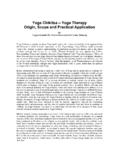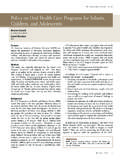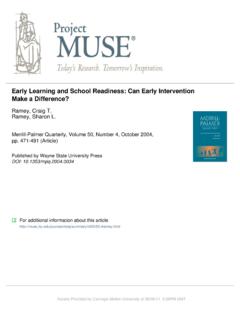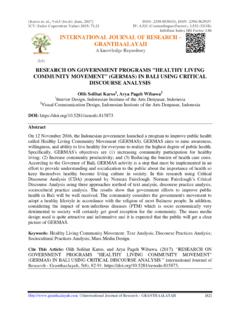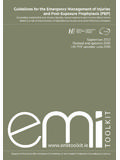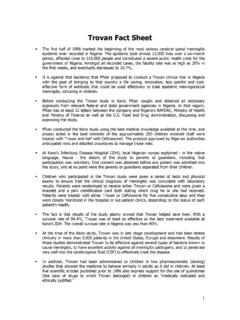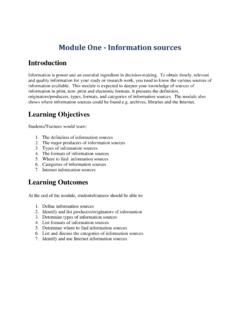Transcription of Yogacharya Dr. ANANDA BALAYOGI BHAVANANI,
1 SWARODAYA VIGJNAN A Scientific Analysis of the Nasal Cycle and its Applications Yogacharya Dr. ANANDA BALAYOGI bhavanani , , , , , , Chairman: International Centre for Yoga Education and Research, Pondicherry INTRODUCTION Yoga is the evolutionary process of integration (yuj = union). In the Bhagavad Gita, Lord Krishna says Samatvam yoga uchyate (Yoga is equanimity). The Yogic concept of Loma Viloma (balancing the dwandwas / opposites) encompasses the wide variety of processes in our body, emotions and mind and thus brings about this equanimity of the mind. Yoga and Tantra emphasize the balance between the two halves of the body in terms of Loma and Viloma.
2 The right side of the body is considered to be of masculine nature, endowed with warm, golden, positive, pranic energy and represented by the pingala nadi (energy channel on the right of the sushumna). The left side of the body is considered feminine and endowed with cool, silvery, negative, apanic energy and represented by the ida nadi (energy channel on the left of the sushumna). The sushumna nadi is the energy channel that runs down the middle of the central canal of the spinal cord. (Note: All these energy channels are in the pranamaya kosha though they have correlating structures in the physical body).
3 The Yogin attempts to understand, harness and bring about a balance between the energies of the two halves of the body. The best practical example of this concept is found in the study of the nasal cycle. The nasal cycle is an ultradian rhythm of nasal congestion and decongestion with a quasi-periodicity of 60 to 240 minutes. Keyser made the first formal description and the use of the term nasal cycle in 1895. However the concept of the nasal cycle and an understanding of its role in our life had existed for long before that in Indian thought.
4 The Vedic science of understanding the function of the nasal cycle was known as Swarodaya Vigjnan (swara = sonorous sound produced by the airflow through the nostrils in the nasal cycle, udaya = functioning state, and vigjnan = knowledge). The Shivaswarodaya, an ancient treatise in Sanskrit literature advises the Yogi to undertake quieter, passive activities (soumya karya) when the left nostril flow is dominant (ida / chandra swara), to engage in challenging and exertional activities (roudra karya) when right nostril is dominant (pingala / surya swara) and to relax or meditate when the bilateral nasal flow is operational (sushumna swara) as it was considered to be unsuitable for performance of worldly activities.
5 Ida swara (left nostril dominance) was described as feminine, Shakti and moon-like (chandra) while the pingala swara (right nostril dominance) was described as masculine, Shiva and sun-like (surya). Similarly the traditional Indian description of Ardhanarishwara consists of Shakti (the female element) being depicted on the left and Shiva (the male element) on the right side of the body. Such a notion of left-right, female-male duality was common in oriental traditional medicine as also in western alchemy. The nasal cycle has been demonstrated not only in man but also in rat, rabbit and domestic pig.
6 TRADITIONAL VIEWS ON SWARA YOGA A. Rhythmicity of the swara Textbooks of swara yoga (Charandas, 1954; Kannan, 1967; Gautam, 1975) describe a definite pattern of breathing in a healthy person on each day of the month at sunrise. It is said that on days 1,2,3,7,8,9,13,14,15 of the bright fortnight (the two weeks after full moon), the breath is to flow predominantly in the left nostril at sunrise and on days 4,5,6,10,11,12 it is to flow in the right nostril at sunrise. Similarly, on days 1,2,3,7,8,9,13,14,15 of the dark fortnight (the two weeks after the new moon), the breath is to flow predominantly in the right nostril at sunrise and on days 4,5,6,10,11,12 it is to flow in the left nostril at sunrise.
7 In modern man it is difficult to have these natural patterns due to the haphazard life styles but in preliminary studies conducted on students attending six months Yoga Training at ICYER, Yogamaharishi Dr. Swami Gitananda Giri had reported a definite relationship between the lunar phase and the swara pattern. B. Activities prescribed in various swaras 1. Activities prescribed in lunar Swara Initiation of new projects, intake of hot liquids, studies and learning, traveling, dancing, singing, weddings and other auspicious ceremonies are prescribed to be performed when in the lunar (left nostril dominant) swara.
8 2. Activities prescribed in solar swara Strenuous activities such as sporting activities, creative writing, commencing of battle, intake of food, sleep and extension of business are prescribed activities to be performed when in the solar (right nostril dominant) swara. 3. Activities prescribed in sushumna swara During the time that both nostrils are functioning equally, it is prohibited to perform any worldly activities and the activities advised are Yogabhyasa, mediation, puja and other such spiritual and relaxing activities. C. Interesting observations on swara yoga Some interesting observations that are made in relation to swara yoga are; 1.
9 Major meals should be partaken in the solar swara. 2. Bathing should be performed in the solar swara and there is danger of catching cold if done in the lunar swara. 3. Articles of hot potency should be taken in the lunar swara as also liquids. 4. Articles of cold potency should be taken in solar swara. 5. One should go to sleep in the solar swara. 6. If male partner has solar swara and female partner has lunar swara during coitus, then the child conceived will be male. The converse would beget a female child (This interesting observation would be worth being studied scientifically).
10 7. If a person has headache, cold, hypertension, acidity or asthmatic attack, the change of his swara pattern artificially to the opposite swara may benefit and give relief within an hour. (Again this is worth being studied scientifically, as it would be of use in immediate symptomatic benefit for patients found true.) 8. Indulgence in coitus during flow of same swara of both partners will not result in pregnancy. (Worth scientific investigation as it would be a very effective family planning method is found to be true.) MECHANISM OF NASAL CYCLE Various mechanisms were postulated for the occurrence of the nasal cycle and a great amount of research work has been done in this field.


